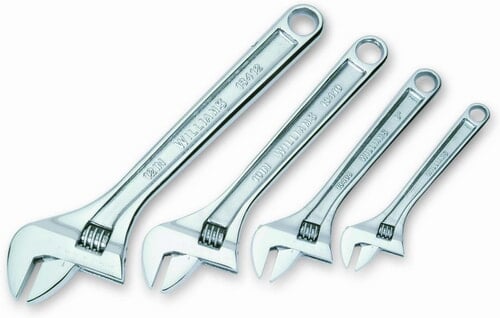Hand Tools

How to Properly Use an Adjustable Wrench: Tips and Techniques
An adjustable wrench is a versatile tool commonly used for tightening and loosening nuts, bolts, and other fasteners. Its adjustable jaw allows for versatility in handling various sizes of fasteners. However, using an adjustable wrench effectively requires proper technique to ensure safety and optimal performance. This blog will provide helpful tips and techniques for properly using an adjustable wrench, allowing you to tackle your DIY projects confidently.
Select the Right Size:
Before using an adjustable wrench, select the correct size for the fastener you are working with. Adjust the jaw opening to fit the fastener snugly. A loose fit may cause slipping or rounding of the fastener, while an overly tight fit can damage both the fastener and the wrench.
Position the Wrench Correctly:
Position the wrench so that the fixed end of the jaw is in contact with the flat side of the fastener. This ensures maximum surface contact and reduces the risk of slippage. Align the wrench perpendicular to the fastener to provide better leverage and prevent damage to the wrench.
Adjust the Wrench Properly:
To adjust the jaw opening:
- Loosen the knurled wheel or nut on the wrench’s handle.
- Slide the movable jaw to the desired size and then tighten the wheel or nut to secure it in place.
- Avoid overtightening, as it may cause the wrench to jam or become difficult to adjust later.
Apply Steady Pressure:
Applying steady and even pressure to turn the fastener when using the adjustable wrench. Avoid excessive force, as it may damage the wrench, the fastener, or the surrounding components. Consider using a longer-handled wrench for increased leverage if the fastener is too tight or stubborn.
Maintain Proper Grip:
Hold the adjustable wrench securely with a firm grip on the handle. Ensure that your hand is positioned on the fixed end of the wrench, away from the adjustable jaw. This helps prevent accidental adjustments and provides better control over the wrench.
Avoid Overextending the Handle:
Avoid overextending the handle of the adjustable wrench to prevent damage and ensure a smooth operation. Overextending can lead to excessive flexing, reducing the wrench’s effectiveness and potentially causing it to break.
Lubricate Stuck Fasteners:
If you encounter a stuck or rusted fastener, applying a penetrating oil or rust, dissolver can help loosen it. Allow the lubricant to penetrate for a few minutes before attempting to turn the fastener with the adjustable wrench. This reduces the risk of damaging the fastener or wrench due to excessive force.
Use the Correct Direction of Rotation:
Ensure you turn the adjustable wrench in the correct direction to tighten or loosen the fastener. Remember the “righty tighty, lefty loosey” rule: clockwise rotation tightens the fastener, while counterclockwise rotation loosens it.
Inspect the Wrench Regularly:
Regularly inspect your adjustable wrench for signs of wear, damage, or loose parts. Check for any deformation, worn jaws, or excessive play in the movable jaw. Replace or repair a worn or damaged wrench for safe and effective use.
Store the Wrench Properly:
Store your adjustable wrench in a dry and clean area when not in use. Please keep it away from moisture and corrosive substances to prevent rust or damage to the tool. Avoid tossing the wrench loosely in your toolbox, as it may cause unnecessary wear or damage.
Conclusion:
Properly using an adjustable wrench involves:
- Selecting the correct size.
- Positioning it correctly.
- Applying steady pressure.
- Maintaining a firm grip.
By following these tips and techniques, you can ensure the safe and effective use of the adjustable wrench for your DIY projects. Inspect the wrench regularly for wear and store it properly to maintain its longevity. With the proper technique, your adjustable wrench will be a valuable tool in your toolbox, enabling you to tackle tightening and loosening tasks confidently.